





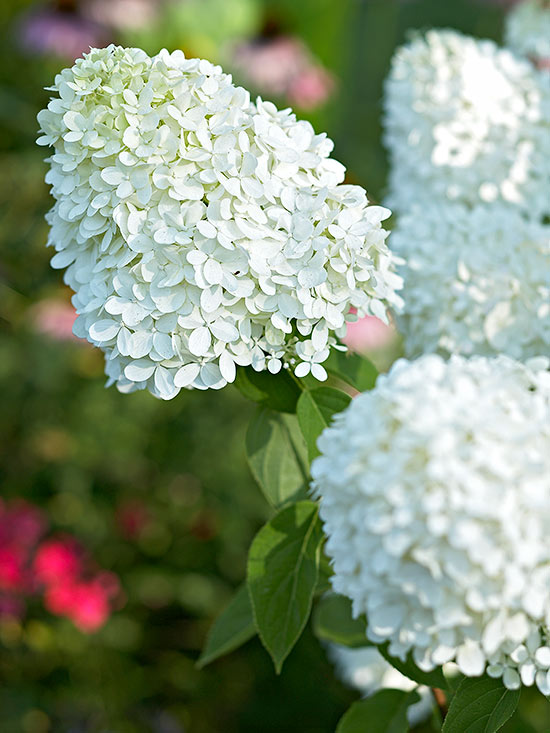
With all their wonderful diversity of size, shape, foliage, and flower, shrubs can turn a mundane piece of property into a beautiful showplace. Shrubs make the yard inviting and livable. You've probably noticed that builders always plant a few shrubs around newly constructed homes. There may be no trees or grass, but there are shrubs.
Shrubs, with their deciduous or evergreen foliage, are enormously decorative and highly useful. Like trees, evergreen shrubs may have broadleaf or needled foliage and can offer colorful berries or cones, interesting bark, and lovely flowers. Even in winter, their leafless, contorted trunks and interesting architecture enhance the landscape. Their size provides a pleasant transition between tall trees and groundcover plantings, softening the edges of boundaries, foundations, buildings, and walls. They also protect the soil, supporting and sheltering all kinds of wildlife.
Shrubs are versatile. Use them as groundcovers on slopes, as living walls, as backdrops for flower borders, and as screens to block street noise and dust. Put them where they'll obscure landscape eyesores, such as heating and cooling units, swimming pool mechanicals, utility meters, and trash can areas.
Add blooms to your yard with these flowering shrubs.
continue reading belowUse shrubs to accent pools, patios, and dooryards. Or plant thorny varieties to redirect children and animals using your yard for shortcuts.
Conifers are generating renewed interest. These cone-bearing, needled evergreens are available in dwarf forms -- more suitable scale for today's smaller properties. They offer an amazing array of foliage color -- soft blue, variegations in yellow or cream with green, as well as the traditional green. Whatever the colors, they really stand out in a winter landscape. Conifers also come in many forms -- weeping, prostrate, and topiary, in addition to the usual upright configuration.
Native shrubs are also enjoying long-overdue attention. Because they have existed in the same region long before European settlers arrived, and have adapted to local climate and soil conditions. Unfortunately, Americans temporarily lost interest in them, while other countries happily adopted them. But now we're recognizing their many low-maintenance virtues. They don't require extra watering and tend to resist pest insects and disease. And they're big favorites of local wildlife.
In many areas of the country, rainfall is never generous. And it's becoming less dependable in many other areas, too. If you live where water is likely to be restricted, choose shrubs that don't require much water. Some examples are olive, butterfly bush, potentilla, and barberry.
Deer can damage shrubs by nibbling their twigs, fruit, and foliage. Homeowners across the country are searching for ornamental shrubs that deer will ignore. Lists vary by region -- even by neighborhood -- but certain types of plants appear on many of them. Consider shrubs with thorns or prickers, resinous wood, aromatic foliage, and silver or gray fuzzy leaves.
Native shrubs that combine the virtues of beauty and low maintenance include:
Some shrubs with berries that attract birds and other wildlife include:
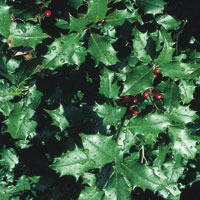 American holly.
American holly.
American holly can grow 30 to 40 feet tall and is pyramidally shaped. This hardy evergreen has leathery, glossy, spined leaves. Female trees bear red or yellow berries that attract birds. Hardy to Zone 5.
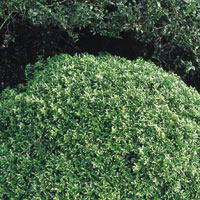 Boxwood.
Boxwood.
Boxwood is an evergreen covered with tiny, oval, glossy leaves. It tolerates shearing into hedges very well. Common boxwood grows to 20 feet tall and accepts sun or light shade. Hardy to Zone 6.
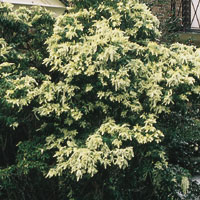 Andromeda.
Andromeda.
Andromeda, or pieris, is a 4- to 12-foot-tall, broadleaf evergreen. It bears pendulous clusters of fragrant, white, urn-shaped florets in the spring. This slow-growing shrub likes some shade. Zones 6 to 9.
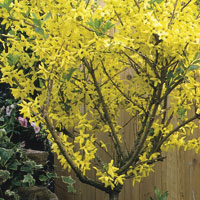 Forsythia.
Forsythia.
Forsythia bears rows of bright yellow, trumpet-shaped flowers on its bare stems in early spring. It becomes 8 to 10 feet tall. Hardy to Zone 5.
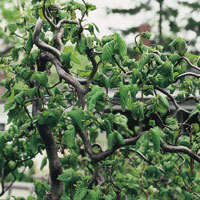 Harry Lauder's walking stick.
Harry Lauder's walking stick.
Harry Lauder's walking stick is actually a filbert used as an ornamental shrub. It has coarse, veined leaves and grows 8 to 10 feet tall. Zones 4 to 9.
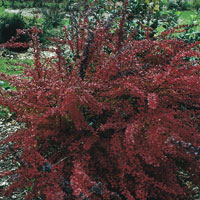 Japanese barberry.
Japanese barberry.
Japanese barberry grows 2 to 5 feet tall and is tough and versatile, even in poor, dry soil. Its small red berries persist all fall. Hardy to Zone 5.
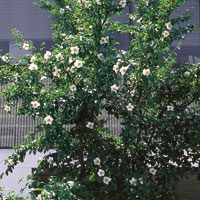 Korean stewartia.
Korean stewartia.
Korean stewartia has delicate white blossoms in early summer. Its leaves turn orange-red in the fall, then drop to expose patchy bark. Zones 5 to 7.
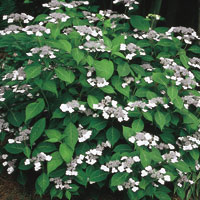 Lace-cap hydrangea.
Lace-cap hydrangea.
Lace-cap hydrangea features flat clusters of tiny, tight, fertile flowers ringed by petaled, sterile ones. The blue or pink flowers nestle among green foliage in early summer. Hardy to Zone 6.
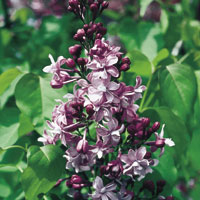 Lilac.
Lilac.
Lilac boasts fragrant sprays of tiny, tubular florets in pink, white, and shades of lavender during the spring. Heart-shaped, smooth, bluish green leaves continue through the season and drop in the fall. Lilac grows slowly but lives a long time. Zones 4 to 9.
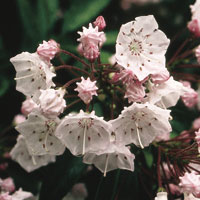 Mountain laurel.
Mountain laurel.
Mountain laurel is a broadleaf evergreen that grows to 15 feet tall. It's vigorous and bears globes of intricate, starlike florets in late spring. Use it as a specimen or in woodland settings. Zones 4 to 9.
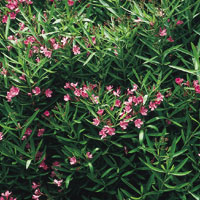 Oleander.
Oleander.
Oleander tolerates heat, drought, and salt and takes any soil. Narrow evergreen foliage lines thin branches tipped with colorful flowers all season. Caution: All parts of the plant are poisonous. Zone 9.
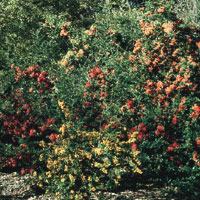 Pyracantha.
Pyracantha.
Pyracantha (firethorn) branches are covered with thorns. They bear white flowers in spring that become bright orange or red berries by fall. Its smallish, oval leaves are evergreen. This shrub is easy to grow but difficult to prune. Zones 5 to 9.
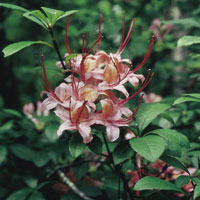 Plum-leaf azalea.
Plum-leaf azalea.
Plum-leaf azalea, native to the Southeast, bears its fragrant, orange-red flowers in midsummer, later than most azaleas. Shrubs have evergreen foliage and grow to 10 feet or more. Zones 5 to 8.
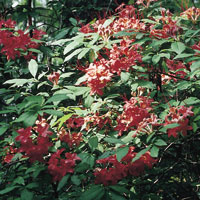 PJM rhododendron.
PJM rhododendron.
PJM rhododendron is a compact evergreen that grows 3 to 6 feet tall. Resembling an azalea, its leaves are small and leathery, turning purplish in the fall. Spring flowers are pinkish-lavender. Zones 4 to 9.
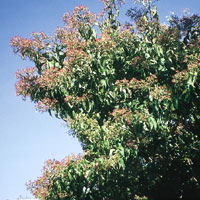 Seven-sons flowers.
Seven-sons flowers.
Seven-sons flowers' soft green foliage shows off its 6-inch-long clusters of fragrant ivory flowers in late summer. It likes moist, woodsy soil (but tolerates less) and grows to 15 feet. Zones 5 to 8.
Copyright © www.100flowers.win Botanic Garden All Rights Reserved